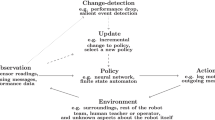Abstract
Unmanned ground vehicles tend to be more and more autonomous, but both complete teleoperation and full autonomy are not efficient enough to deal with all possible situations. To be efficient, the human–robot system must be able to anticipate, react and recover from errors of different kinds, i.e., to be resilient. From this observation, this paper proposes a survey on the resilience of a human–machine system and the means to control the resilience. The resilience of a system can be defined as the ability to maintain or recover a stable state when subject to disturbance. Adjustable autonomy and human–machine cooperation are considered as means of resilience for the system. This paper then proposes three indicators to assess different meanings of resilience of the system: foresight and avoidance of events, reaction to events and recovery from occurrence of events. The third of these metrics takes into consideration the concept of affordances that allows a common representation for the opportunities of action between the automated system and its environment.










Similar content being viewed by others
References
Amalberti R (2006) Optimum system safety and optimum system resilience: agonistic or antagonistic concepts? In: Hollnagel E et al (eds) Resilience engineering: concepts and precepts. Ashgate, UK, pp 253–271
Benford S, Fahlén L (1993) A spatial model of interaction in large virtual environments. In: Proceedings of the third European conference on computer supported cooperative work (ECSCW’93), Milan, pp 109–124
Bradshaw JM, Feltovitch PJ, Jung H, Kulkarni S, Taysom W, Uszok A (2004) Dimensions of adjustable autonomy and mixed-initiative interaction. In: Nickles M et al (eds) AUTONOMY LNAI 2969. Springer, Berlin, pp 17–39
Dorais GA, Bonasso RP, Kortenkamp D, Pell B, Schreckenghost D (1998) Adjustable autonomy for human-centered autonomous systems on Mars. In: Proceedings of the 1st international conference of the mars society, Boulder, CO
Fiksel J (2003) Designing resilient, sustainable systems. Environ Sci Technol 37(23):5330–5339
Fong T, Thorpe C, Baur C (2003) Robot, asker of questions. Robotics Auton Syst 42:235–243
Gaver WW (1991) Technology affordances. In: Proceedings of CHI 91, New Orleans (LA). ACM, New York, pp 79–84
Gibson JJ (1986) The ecological approach to visual perception. Lawrence Erlbaum Associates, Hillsdale Originally published in 1979
Goodrich MA, Olsen DR, Crandall JW, Palmer TJ (2001) Experiments in adjustable autonomy. In: Proceedings of IJCAI workshop autonomy, delegation and control: interacting with intelligent agents
Hollnagel E (1999) Accidents and barriers. In: Proceedings of the 7th European conference on cognitive science approaches to process control, Villeneuve d’Ascq, France, pp 175–180
Hollnagel E (2006) Achieving system safety by resilience engineering. In the 1st institute of engineering and technology international conference on systems safety
Hollnagel E, Woods DD (2006) Epilogue: resilience engineering precepts. In: Hollnagel E et al (eds) Resilience engineering: concepts and precepts. Ashgate, UK, pp 347–358
Inagaki T (2003) Adaptive automation: sharing and trading of control. In: Hollnagel E (ed) Handbook of cognitive task design. Lawrence Erlbaum Associates, Mahwah, pp 147–169
Ludwig D, Walker B, Holling CS (1997) Sustainability, stability and resilience. Conserv Ecol 1(1):7. Available from the internet. http://www.consecol.org/vol1/iss1/art7/
Parasuraman R, Sheridan TB, Wickens CD (2000) A model for types and levels of human interaction with automation. IEEE Trans Syst Man Cybern—Part A Syst Hum 30(3):286–297
Sahin E, Cakmak M, Dogar MR, Ugur E, Uçoluk G (2006). To afford or not to afford: a new formalization of affordances towards affordance-based robot control. Technical report: Middle East Technical University, Ankara, METU-CENG-TR-2006-02
Schmidt K (1991) Cooperative work: a conceptual framework. In: Rasmussen J et al (eds) Distributed decision making: cognitive models for cooperative work. Wiley, USA, pp 75–110
Sheridan TB (1992) Telerobotics, automation and human supervisory control. MIT Press, Cambridge
Smithers T (1997) Autonomy in robots and other agents. Brain Cogn 34:88–106
Steels L (1995) When are robots intelligent autonomous agents? Robotics Auton Syst 15(1):3–9
Stoffregen TA (2003) Affordances as properties of the animal environment system. Ecol Psychol 15(2):115–134
Westrum R (2006) A typology of resilience situations. In: Hollnagel E (ed) Resilience engineering: concepts and precepts. Ashgate, UK, pp 55–65
Wreathall J (2006) Properties of resilient organizations: an initial view. In: Hollnagel E (ed) Resilience engineering: concepts and precepts. Ashgate, UK, pp 275–285
Zieba S, Jouglet D, Polet P, Vanderhaegen F (2007) Resilience and affordances: perspectives for human,-robot cooperation?, EAM’07-26th European annual conference on human decision-making and manual control, Copenhagen, Denmark
Zieba S, Polet P, Vanderhaegen F, Enjalbert S (2008). Autonomie ajustable et résilience pour une coopération Homme–Robot. Conférence internationale francophone d’automatique, Bucharest, Romania, September
Acknowledgments
This work was performed in the Human–Machine Systems research group, in the Laboratoire d’Automatique, de Mécanique et d’Informatique industrielles et Humaines (LAMIH) of the University of Valenciennes. This work is supported by the French Defence Procurement Agency (DGA) and takes place in collaboration with the THALES Company.
Author information
Authors and Affiliations
Corresponding author
Rights and permissions
About this article
Cite this article
Zieba, S., Polet, P., Vanderhaegen, F. et al. Principles of adjustable autonomy: a framework for resilient human–machine cooperation. Cogn Tech Work 12, 193–203 (2010). https://doi.org/10.1007/s10111-009-0134-7
Received:
Accepted:
Published:
Issue Date:
DOI: https://doi.org/10.1007/s10111-009-0134-7




